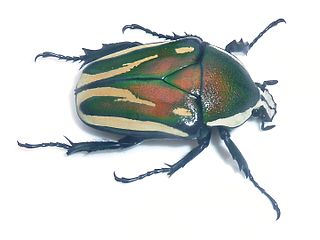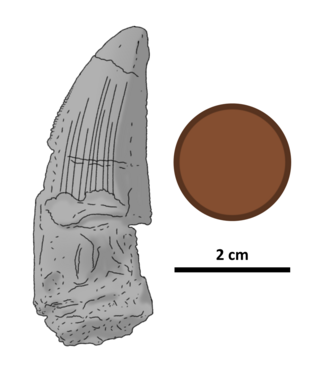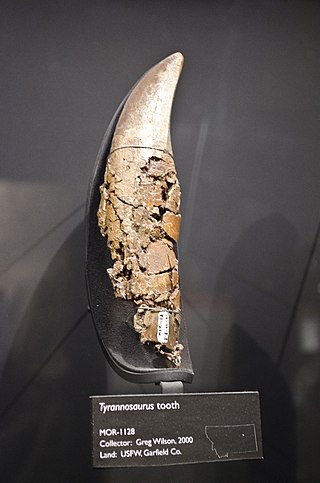
In osteology, the osteon or haversian system is the fundamental functional unit of much compact bone. Osteons are roughly cylindrical structures that are typically between 0.25 mm and 0.35 mm in diameter. Their length is often hard to define, but estimates vary from several millimeters to around 1 centimeter. They are present in many bones of most mammals and some bird, reptile, and amphibian species.

Dryosaurus is a genus of an ornithopod dinosaur that lived in the Late Jurassic period. It was an iguanodont. Fossils have been found in the western United States and were first discovered in the late 19th century. Valdosaurus canaliculatus and Dysalotosaurus lettowvorbecki were both formerly considered to represent species of Dryosaurus.
Professor David Bruce Weishampel is an American palaeontologist in the Center for Functional Anatomy and Evolution at Johns Hopkins University School of Medicine. Weishampel received his Ph.D. in Geology from the University of Pennsylvania in 1981. His research focuses include dinosaur systematics, European dinosaurs of the Late Cretaceous, jaw mechanics and herbivory, cladistics and heterochrony and the history of evolutionary biology. Weishampel's best known published work is The Dinosauria University of California Press; 2nd edition. He consulted for Jurassic Park and is a good friend of Steven Spielberg. He has received an Academy Scientific and Technical Award.

Giraffatitan is a genus of sauropod dinosaur that lived during the late Jurassic Period in what is now Lindi Region, Tanzania. Only one species is known, G. brancai, named in honor of German paleontologist Wilhelm von Branca, who was a driving force behind the expedition that discovered it in the Tendaguru Formation. Giraffatitan brancai was originally described by German paleontologist Werner Janensch as a species of the North American sauropod Brachiosaurus from the Morrison Formation, as Brachiosaurus brancai. Recent research shows that the differences between the type species of Brachiosaurus and the Tendaguru material are so large that the African material should be placed in a separate genus.

Dysalotosaurus is a genus of herbivorous iguanodontian dinosaur. It was a dryosaurid iguanodontian, and its fossils have been found in late Kimmeridgian-age rocks of the Tendaguru Formation of Lindi Region in Tanzania. The type and only species of the genus is D. lettowvorbecki. This species was named by Hans Virchow in 1919 in honor of the Imperial German Army Officer, Paul von Lettow-Vorbeck. For much of the 20th century the species was referred to the related and approximately contemporary genus Dryosaurus, but newer studies reject this synonymy.

Dicronorhina derbyana, or Derby's flower beetle, is a sub-Saharan species of flower chafer.

Ostafrikasaurus is a genus of theropod dinosaur from the Late Jurassic period of what is now Lindi Region, Tanzania. It is known only from fossil teeth discovered sometime between 1909 and 1912, during an expedition to the Tendaguru Formation by the Natural History Museum of Berlin. Eight teeth were originally attributed to the dubious dinosaur genus Labrosaurus, and later to Ceratosaurus, both known from the North American Morrison Formation. Subsequent studies attributed two of these teeth to a spinosaurid dinosaur, and in 2012, Ostafrikasaurus crassiserratus was named by French palaeontologist Eric Buffetaut, with one tooth as the holotype, and the other referred to the same species. The generic name comes from the German word for German East Africa, the former name of the colony in which the fossils were found, while the specific name comes from the Latin words for "thick" and "serrated", in reference to the form of the animal's teeth.

Laquintasaura is a genus of Venezuelan ornithischian dinosaur containing only the type species Laquintasaura venezuelae. The species was the first dinosaur to have been identified from Venezuela. It is known from extensive remains, all from a single bonebed locality which has been sampled for specimen blocks over the course of several expeditions, largely led by Marcelo R Sánchez-Villagra. A small animal, it is known for its distinct dental anatomy and for being one of the earliest and most primitive ornithischians in the fossil record. Taxonomic uncertainty has led to conflicting hypotheses that it is either at the base of Ornithischia or at the base of the subgroup Thyreophora. In either model, its dating to around 200 million years ago at the start of the Jurassic, existence in equatorial latitudes, and primitive nature make it a key insight into early ornithischian evolution. It is thought that Laquintasaura would have lived in groups and had a possible omnivorous diet, living on a seasonal alluvial plain and being preyed upon by the contemporary Tachiraptor.
Mycerinodes is a genus of longhorn beetles of the subfamily Lamiinae, containing the following species:
Megalobrimus is a genus of longhorn beetles of the subfamily Lamiinae, containing the following species:
Mycerinodes lettowvorbecki is a species of beetle in the family Cerambycidae. It was described by Kriesche in 1926, originally spelled as "Mycerinodes Lettow-Vorbecki".
Megalobrimus annulicornis is a species of beetle in the family Cerambycidae. It was described by Stephan von Breuning in 1959. It is known from Tanzania.
Megalobrimus densegranulatus is a species of beetle in the family Cerambycidae. It was described by Stephan von Breuning in 1969. It is known from Cameroon.
Megalobrimus parvus is a species of beetle in the family Cerambycidae. It was described by Stephan von Breuning in 1969. It is known from Cameroon.
Megalobrimus granulipennis is a species of beetle in the family Cerambycidae. It was described by Stephan von Breuning in 1954. It is known from Tanzania.
Megalobrimus ingranulatus is a species of beetle in the family Cerambycidae. It was described by Stephan von Breuning in 1936. It is known from the Democratic Republic of the Congo.
Megalobrimus scutellatus is a species of beetle in the family Cerambycidae. It was described by Per Olof Christopher Aurivillius in 1916. It is known from Tanzania and Malawi.
Thylactus lettowvorbecki is a species of beetle in the family Cerambycidae. It was described by Kriesche in 1924, originally published as "Thylactus lettow-vorbecki". It is known from Tanzania.

Dinosaur teeth have been studied since 1822 when Mary Ann Mantell (1795-1869) and her husband Dr Gideon Algernon Mantell (1790-1852) discovered an Iguanodon tooth in Sussex in England. Unlike mammal teeth, individual dinosaur teeth are generally not considered by paleontologists to be diagnostic to the genus or species level for unknown taxa, due morphological convergence and variability between teeth. and many historically named tooth taxa like Paronychodon and Richardoestesia are today considered nomina dubia, and are used as form taxa to refer to isolated teeth from other localities displaced considerably in time and space from the type specimens. However, it is possible to refer isolated teeth to known taxa provided that the tooth morphology is known and the teeth originate from a similar time and place.







